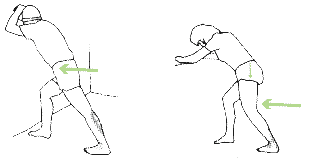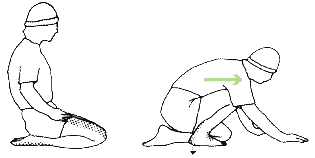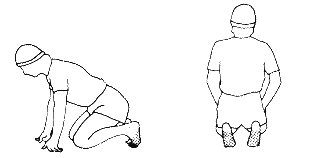The two key components are stretching and support.
You can augment support by either increasing control of the foot from below or reducing the load. If you are overweight a loss of as little as 5 pounds can give dramatic results. Foot supports or prescription orthotics control the foot from in the shoe. If you are in sever pain and this condition is interfering with your daily life see a Podiatrist immediately.
- Wear a good supportive shoe. This is a shoe with a rigid counter (The area of the shoe around the sides of the heel.) It should be difficult to press this area of the shoe in. Most New Balance® Sneakers are good examples of shoes with a rigid counter. I recommend all patients obtain tie shoes with a rigid counter in the correct width and length.
- Support the foot. First try OTCSpenco Arch Cushions® 3/4 length.
- Stretch the muscles and ligaments of the foot and lower leg at least twice daily.
- After using the above in combination for a week or two if you are still experiencing discomfort non-steroidal anti-inflammatory medications can be given.
- If there is less then a 50% improvement after month then it is time to see a doctor. Depending on the severity of the condition he may want X-rays or a Sonogram of the foot.
- A prescription custom orthotic may be necessary, and night splints prescribed to augment stretching.
50 % of patients are improved with stretching, the Spenco Arch Cushion combined with a rigid counter tie shoe in about 4 weeks.
Anti-inflammatory medication will hasten pain reduction. If after a month results are still not satisfactory a visit to a podiatrist is recommended. Prescription Orhtotics offer the best control of the foot. If pain persists, local steroid injections are often helpful. If you are overweight a serious attempt should have been made to reduce weight.
Surgical intervention should not be considered until the patient has failed at least 6 months of conservative therapy. Which includes an examination by a podiatrist; and use of prescription Orthotics (not over the counter shoe inserts) and stretching. I would also recommend ESWT treatment before surgery. If surgery is necessary it may include release of the plantar fascia, removal of the heel spur and or freeing up the nerve.
Basic Stretch for Achilles tendon and Plantar Fascia
 To stretch your calves stand a little away form a solid structure. Lean on your forearms, head resting on hands. Bend one leg and put that foot on the ground in front of you with the other leg straight behind you. Slowly move your hips forward keeping you lower back flat. Be sure to keep your back foot heel on the ground. Hold the stretch for 30 seconds. Do not bounce. Do one set with knee straight and another with the knee slightly bent.
To stretch your calves stand a little away form a solid structure. Lean on your forearms, head resting on hands. Bend one leg and put that foot on the ground in front of you with the other leg straight behind you. Slowly move your hips forward keeping you lower back flat. Be sure to keep your back foot heel on the ground. Hold the stretch for 30 seconds. Do not bounce. Do one set with knee straight and another with the knee slightly bent.
Advanced Achilles Tendon and Plantar Fascia Stretch
 To stretch your calves stand a little away form a solid structure. Lean on your forearms, head resting on hands. Bend one leg and put that foot on the ground in front of you with the other leg straight behind you. Slowly move your hips forward keeping you lower back flat. Be sure to keep your back foot heel on the ground. Hold the stretch for 30 seconds. Do not bounce. Do one set with knee straight and another with the knee slightly bent.
To stretch your calves stand a little away form a solid structure. Lean on your forearms, head resting on hands. Bend one leg and put that foot on the ground in front of you with the other leg straight behind you. Slowly move your hips forward keeping you lower back flat. Be sure to keep your back foot heel on the ground. Hold the stretch for 30 seconds. Do not bounce. Do one set with knee straight and another with the knee slightly bent.
Kneel. Bring the toes of one foot almost even to the knee of the other leg Let the heel of the bent leg come off the ground a half inch or so Lower the heel toward the ground while pushing forward on your thigh. The idea is not to get the heel flat but to use forward pressure of your upper body to give and easy stretch. A very slight stretch is all that is needed. Hold for 10 seconds.
Advanced Plantar Facsia Stretch
 Kneel on the floor. Put your hands in front of you for balance. Slowly lean backward until you feel a mild stretch. Stretch easily for about 15 seconds.
Kneel on the floor. Put your hands in front of you for balance. Slowly lean backward until you feel a mild stretch. Stretch easily for about 15 seconds.
